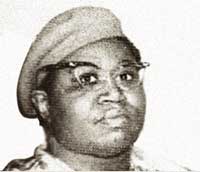
Follow workers.org on



RED HOT: TRAYVON MARTIN
CHINA,
AFGHANISTAN, FIGHTING RACISM, OCCUPY WALL STREET,
PEOPLE'S POWER, SAVE OUR POST OFFICES, WOMEN, AFRICA,
LIBYA, WISCONSIN WORKERS FIGHT BACK, SUPPORT STATE & LOCAL WORKERS,
EGYPT, NORTH AFRICA & MIDDLE EAST,
STOP FBI REPRESSION, RESIST ARIZONA RACISM, NO TO FRACKING, DEFEND PUBLIC EDUCATION, ANTI-WAR,
HEALTH CARE,
CUBA, CLIMATE CHANGE,
JOBS JOBS JOBS,
STOP FORECLOSURES, IRAN,
IRAQ, CAPITALIST CRISIS,
IMMIGRANTS, LGBT, POLITICAL PRISONERS,
KOREA,
HONDURAS, HAITI,
SOCIALISM,
GAZA



|
|
Mae Mallory: unforgettable freedom fighter promoted self-defense
Published Feb 26, 2009 10:38 PM
By Jeanette Merrill and Rosemary Neidenberg
Mae Mallory was a leading figure in the movement for Black liberation in the
1960s, and especially known as a proponent of the right of Black people to
armed self-defense.
Once recalling conditions at her children’s school in Harlem, Mallory
wrote: “I represented the Parents Association in Albany and spoke about
the miserable condition of P.S. 10. They were not prepared for this angry Black
woman. Brand new toilets were put in immediately.
“We needed a new school. Getting that school gave me so much confidence
that you can fight City Hall and win. ... We finally boiled down to nine that
stuck all the way. We were known as the Harlem Nine.” (“Letters
from Prison,” by Mae Mallory. Monroe Defense Committee, circa 1962).
Students researching her life and her contributions still ask to go through
Workers World’s archives to learn the true history of this heroic Black
woman warrior.
Of all her life’s battles, before her death in 2007, the hardest one
established Mallory’s political role. It began with her support and
fundraising for Rob Williams, a leading advocate of armed self-defense for
Black people in the fight against violent racism.
From Monroe, N.C., in 1961, came Williams’ decisive call to Mallory in
New York: “Mabel and I need you down here.”
Rob Williams had come home to Klan-infested Monroe from the U.S. Marines. He
recruited Black WW II veterans into a working-class chapter of the NAACP. They
fought to desegregate the local swimming pool.
Some in the civil rights movement at that time advocated nonviolent civil
disobedience. Williams, however, organized armed pickets, who withdrew only
when the city closed the pool. Faced with increasing threats and deadly
violence, Williams and his self-defense guards protected the resisting Black
community. In the newsletter named “The Crusader,” which Williams
printed on a mimeograph machine, Williams called on all Black communities to do
the same.
In one confrontation, racists forced Williams’ car off the road. One held
a gun to his head. One of Williams’ young supporters jammed his gun
against the skull of the would-be killer. His bold action saved
Williams’s life.
When 17 Freedom Riders came to Monroe to support Williams, a dramatic debate
developed between the ideologies of passive resistance—which the Freedom
Riders supported—and Williams’ armed self-defense. Williams warned
the brave young idealists that racists would confront passive resisters with
violence.
In “Negroes with Guns,” a pamphlet published originally by
Workers World, Williams described brutal beatings and shooting
attacks on the Freedom Riders. At the peak of the battle between Black people
and the racists in Monroe there were thousands of armed people menacing each
other.
When the tension was greatest, in August 1961, an elderly white couple, the
Steagalls, drove into the neighborhood. To protect them from the possible wrath
of the community, Williams offered shelter in his home where he, Mabel Williams
and Mae Mallory were preparing food for the Freedom Riders. The Steagalls
gratefully accepted his offer.
After two hours the neighborhood was less tense and the Steagalls left. Later
this same couple testified that they had been held against their will. The
state brought indictments of kidnapping against Mallory and Williams and
charges of complicity against three others.
Facing what they knew would be an unfair, racist trial if not a lynching, Rob
Williams and Mabel Williams escaped to young socialist Cuba. Mae Mallory went
to Cleveland and found “justice” Northern style.
Cleveland chronology
1961—Oct. 12: Arrested by FBI agents and imprisoned in
Cuyahoga County Jail. Oct. 18:Released on $7,500 bail. Workers World Party
members Frances Dostal and Ted Dostal used their house as collateral for the
bail.
1962—March 11: Bail revoked. Oct. 4: Ohio State Supreme
Court refuses attorney Walter Haffner’s plea to stop extradition.
1963—Dec. 2: U.S. Supreme Court turns down appeal by
attorneys Len Holt and Walter Haffner to stop extradition.
1964—January: Extradited to North Carolina.
The Monroe Defense Committee
Mallory’s 1961 call from jail to Workers World Party resulted in the
establishment of a Monroe Defense Committee office in Harlem and one in
Cleveland, where rotating teams of Workers World Party members maintained an
office/apartment. Young Audrey Proctor Seniors worked in a coffee shop
patronized by MDC members and enthusiastically agreed to receive mail,
shielding it from the FBI. She took telephone messages to bypass the office
tap.
MDC Chairperson Clarence Seniors, Vera Spruill, Ruth Stone, Frances Dostal and
others kept the office open. They organized demonstration after demonstration,
large and small, always loud, always imaginative. Aided by the New York MDC,
they raised the money needed to maintain the offices, for legal expenses and
bail, and succeeded in building national and worldwide interest.
Among the MDC supporters were Bertrand Russell, James Baldwin, Cleveland CORE,
James Foreman, Julian Mayfield, the National Lawyers Guild, the American Civil
Liberties Union, the American Humanist Association, Dick Gregory, the Ghana
Evening News, Ruby Dee and Ossie Davis.
Mae Mallory’s prison writings bristle with rebellion and condemnations of
the racist system and the top-of-the-heap racists. Caged though she was for
most of the Cleveland years, her unquenchable spirit and voice were huge assets
to the campaign for her own freedom and that of the other defendants.
A Monroe Defense Committee undated leaflet commented on the hard-fought
campaign to keep Mallory out of Monroe, where her life would unquestionably
have been in danger: “On many occasions she was offered all kinds of
deals if she would renounce her militant approach and disassociate herself from
Rob Williams. ... She and the other collaborators with Williams refused. ... It
was Mrs. Mallory’s passionate advocacy of these ideas in her writings,
letters and speeches over two-and-a-half years which made [the extradition]
inevitable.”
On trial in Monroe; chronology
1964—January: Extradited from Ohio. Sheriff drives
Mallory to Monroe. MDC sets up in Monroe. Jan. 18: Len Holt posts $10,000 bail
releasing Mallory from Union County jail. Feb. 27: After deliberating 32
minutes, a white jury finds Mae Mallory, Richard Crowder and Harold Reape
guilty, sentencing Mallory to 16-20 years. Crowder and Reape, who had been
present at the Steagall incident, were given lesser sentences. Back to Union
County jail.
March 16: MDC raises Mae’s $10,000 cash bail and smaller amounts for
other defendants. April 30: At Columbia University, New York City, Mallory
supports the tactic of stalling the ways to protest racism at the World’s
Fair. Soon after, she attends a meeting of U.S. activists addressed by Che
Guevara, who was representing Cuba at the United Nations.
1965—Jan. 29: Because the jury list for the trial was
segregated, the Supreme Court of North Carolina throws out the Monroe
court’s verdict. Mallory is free.
head: Malcolm X and Tanzania
After this victory, Mallory addressed thousands of people in many cities and at
many colleges, always advocating for armed defense as practiced by Rob Williams
and the Louisiana-based Deacons for Defense.
On Feb. 21, 1965, Mallory witnessed the assassination of Malcolm X from a front
row in the Audubon Ballroom. Later, speaking in Buffalo, N.Y., she said,
“A Black hand pulled the trigger, but it had a white CIA brain behind
it.”
Her view extended well beyond the U.S. In April 1965, she played a key role in
a protest in Times Square in New York of the U.S. military intervention in the
Dominican Republic. On Aug. 8, 1966, speaking before tens of thousands at an
anti-Vietnam War rally, Mallory said, “We are inspired by and salute the
great People’s Republic of China.”
Mallory always had a great love for and interest in Africa. When she told a
comrade that she was going to Tanzania—where she remained for five
years—she said, “I’m going home.”
Articles copyright 1995-2012 Workers World.
Verbatim copying and distribution of this entire article is permitted in any medium without royalty provided this notice is preserved.
Workers World, 55 W. 17 St., NY, NY 10011
Email: [email protected]
Subscribe [email protected]
Support independent news DONATE
|
|


